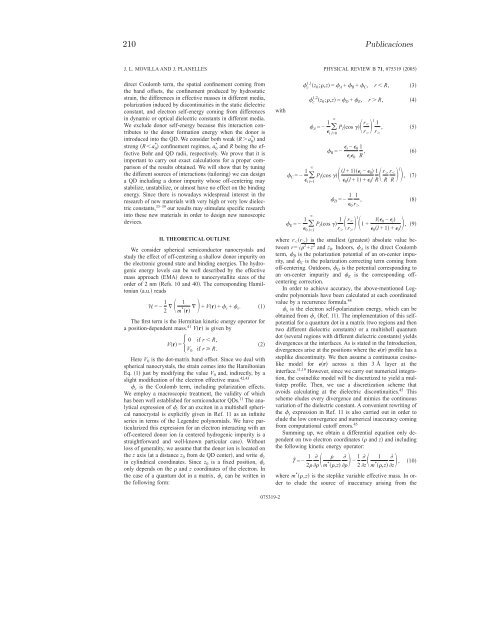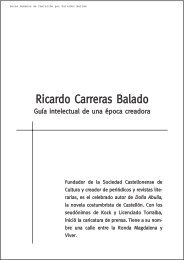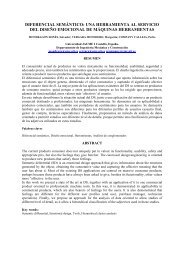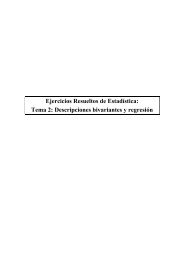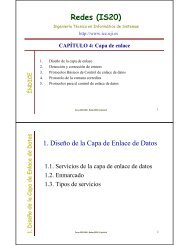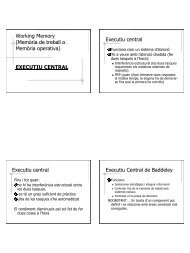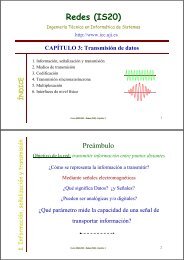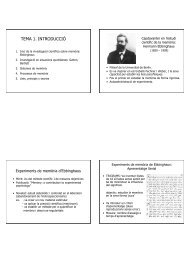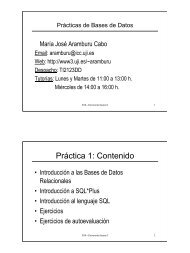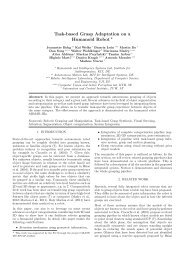CONFINAMIENTO NANOSC´OPICO EN ESTRUCTURAS ... - It works!
CONFINAMIENTO NANOSC´OPICO EN ESTRUCTURAS ... - It works!
CONFINAMIENTO NANOSC´OPICO EN ESTRUCTURAS ... - It works!
Create successful ePaper yourself
Turn your PDF publications into a flip-book with our unique Google optimized e-Paper software.
210 PublicacionesJ. L. MOVILLA AND J. PLANELLES PHYSICAL REVIEW B 71, 075319 2005direct Coulomb term, the spatial confinement coming fromthe band offsets, the confinement produced by hydrostaticstrain, the differences in effective masses in different media,polarization induced by discontinuities in the static dielectricconstant, and electron self-energy coming from differencesin dynamic or optical dielectric constants in different media.We exclude donor self-energy because this interaction contributesto the donor formation energy when the donor isintroduced into the QD. We consider both weak Ra 0 * andstrong Ra 0 * confinement regimes, a 0 * and R being the effectiveBohr and QD radii, respectively. We prove that it isimportant to carry out exact calculations for a proper comparisonof the results obtained. We will show that by tuningthe different sources of interactions tailoring we can designa QD including a donor impurity whose off-centering maystabilize, unstabilize, or almost have no effect on the bindingenergy. Since there is nowadays widespread interest in theresearch of new materials with very high or very low dielectricconstants, 33–39 our results may stimulate specific researchinto these new materials in order to design new nanoscopicdevices.II. THEORETICAL OUTLINEWe consider spherical semiconductor nanocrystals andstudy the effect of off-centering a shallow donor impurity onthe electronic ground state and binding energies. The hydrogenicenergy levels can be well described by the effectivemass approach EMA down to nanocrystallite sizes of theorder of 2 nm Refs. 10 and 40. The corresponding Hamiltoniana.u. readsH =− 1 2 1m * r + Vr + c + s .The first term is the Hermitian kinetic energy operator fora position-dependent mass. 41 Vr is given by0 if r R,Vr = 2V 0 if r R.Here V 0 is the dot-matrix band offset. Since we deal withspherical nanocrystals, the strain comes into the HamiltonianEq. 1 just by modifying the value V 0 and, indirectly, by aslight modification of the electron effective mass. 42,43 c is the Coulomb term, including polarization effects.We employ a macroscopic treatment, the validity of whichhas been well established for semiconductor QDs. 11 The analyticalexpression of c for an exciton in a multishell sphericalnanocrystal is explicitly given in Ref. 11 as an infiniteseries in terms of the Legendre polynomials. We have particularizedthis expression for an electron interacting with anoff-centered donor ion a centered hydrogenic impurity is astraightforward and well-known particular case. Withoutloss of generality, we assume that the donor ion is located onthe z axis at a distance z 0 from de QD center, and write cin cylindrical coordinates. Since z 0 is a fixed position, conly depends on the and z coordinates of the electron. Inthe case of a quantum dot in a matrix, c can be written inthe following form:1with C =− 1 i c 1,1 z 0 ;,z = A + B + C , r R, 3 c 1,2 z 0 ;,z = D + E , r R, 4 A =− 1 il=1 E =− 1 0l=1l=0P l cos r r B =− i − 0 i 01R ,l 1r ,P l cos l +1 i − 0 1 0 l +1 + i l R r R D =− 1 01r ,P l cos 1r r r l1+56r Rl, 78l 0 − i 0 l +1 + i l, 9where r r is the smallest greatest absolute value betweenr= 2 +z 2 and z 0 . Indoors, A is the direct Coulombterm, B is the polarization potential of an on-center impurity,and C is the polarization correcting term coming fromoff-centering. Outdoors, D is the potential corresponding toan on-center impurity and E is the corresponding offcenteringcorrection.In order to achieve accuracy, the above-mentioned Legendrepolynomials have been calculated at each coordinatedvalue by a recurrence formula. 44 s is the electron self-polarization energy, which can beobtained from c Ref. 11. The implementation of this selfpotentialfor a quantum dot in a matrix two regions and thentwo different dielectric constants or a multishell quantumdot several regions with different dielectric constants yieldsdivergences at the interfaces. As is stated in the Introduction,divergences arise at the positions where the r profile has asteplike discontinuity. We then assume a continuous cosinelikemodel for r across a thin 3 Å layer at theinterface. 11,19 However, since we carry out numerical integration,the cosinelike model will be discretized to yield a multistepprofile. Then, we use a discretization scheme thatavoids calculating at the dielectric discontinuities. 45 Thisscheme eludes every divergence and mimics the continuousvariation of the dielectric constant. A convenient rewriting ofthe s expression in Ref. 11 is also carried out in order toelude the low convergence and numerical inaccuracy comingfrom computational cutoff errors. 45Summing up, we obtain a differential equation only dependenton two electron coordinates and z and includingthe following kinetic energy operator:Tˆ =− 1 2 m * −,z 1 2 m * 10,z z,z1where m * ,z is the steplike variable effective mass. In orderto elude the source of inaccuracy arising from the075319-2


